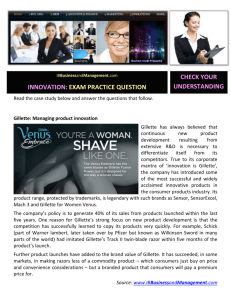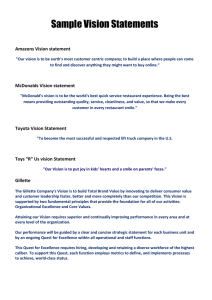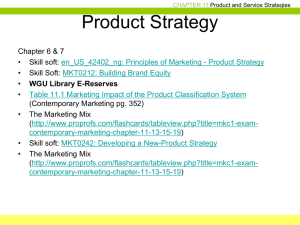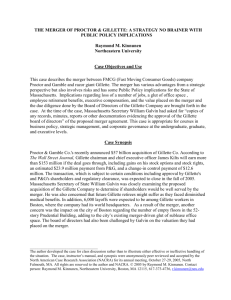Gillette has a razor sharp edge over its competitors
advertisement
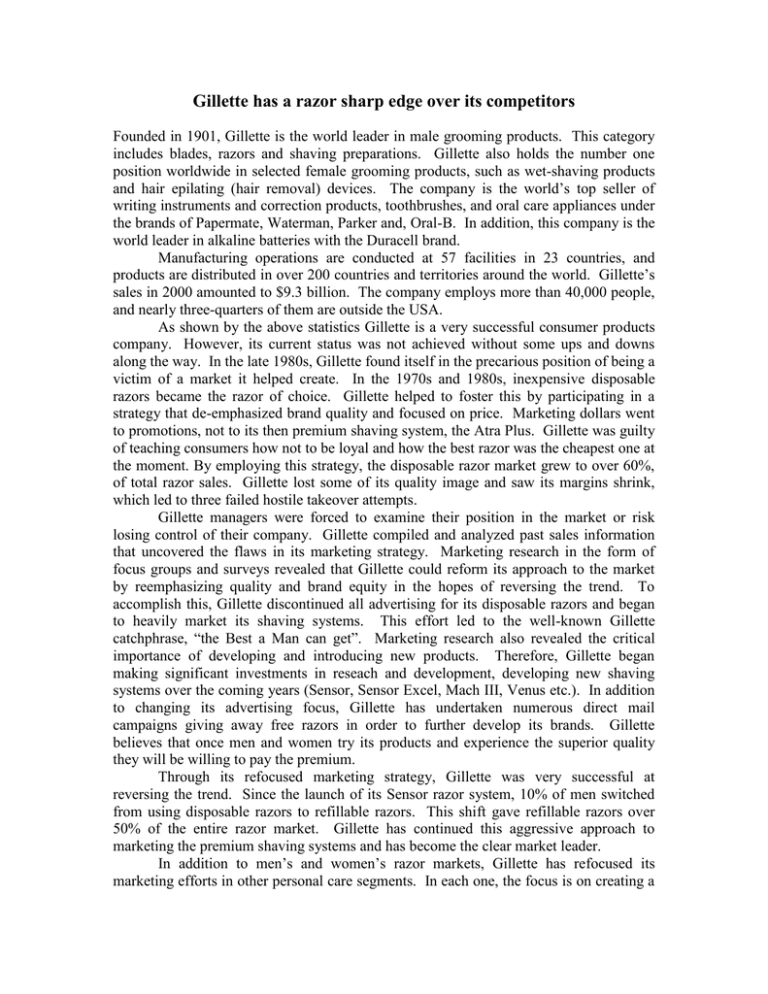
Gillette has a razor sharp edge over its competitors Founded in 1901, Gillette is the world leader in male grooming products. This category includes blades, razors and shaving preparations. Gillette also holds the number one position worldwide in selected female grooming products, such as wet-shaving products and hair epilating (hair removal) devices. The company is the world’s top seller of writing instruments and correction products, toothbrushes, and oral care appliances under the brands of Papermate, Waterman, Parker and, Oral-B. In addition, this company is the world leader in alkaline batteries with the Duracell brand. Manufacturing operations are conducted at 57 facilities in 23 countries, and products are distributed in over 200 countries and territories around the world. Gillette’s sales in 2000 amounted to $9.3 billion. The company employs more than 40,000 people, and nearly three-quarters of them are outside the USA. As shown by the above statistics Gillette is a very successful consumer products company. However, its current status was not achieved without some ups and downs along the way. In the late 1980s, Gillette found itself in the precarious position of being a victim of a market it helped create. In the 1970s and 1980s, inexpensive disposable razors became the razor of choice. Gillette helped to foster this by participating in a strategy that de-emphasized brand quality and focused on price. Marketing dollars went to promotions, not to its then premium shaving system, the Atra Plus. Gillette was guilty of teaching consumers how not to be loyal and how the best razor was the cheapest one at the moment. By employing this strategy, the disposable razor market grew to over 60%, of total razor sales. Gillette lost some of its quality image and saw its margins shrink, which led to three failed hostile takeover attempts. Gillette managers were forced to examine their position in the market or risk losing control of their company. Gillette compiled and analyzed past sales information that uncovered the flaws in its marketing strategy. Marketing research in the form of focus groups and surveys revealed that Gillette could reform its approach to the market by reemphasizing quality and brand equity in the hopes of reversing the trend. To accomplish this, Gillette discontinued all advertising for its disposable razors and began to heavily market its shaving systems. This effort led to the well-known Gillette catchphrase, “the Best a Man can get”. Marketing research also revealed the critical importance of developing and introducing new products. Therefore, Gillette began making significant investments in reseach and development, developing new shaving systems over the coming years (Sensor, Sensor Excel, Mach III, Venus etc.). In addition to changing its advertising focus, Gillette has undertaken numerous direct mail campaigns giving away free razors in order to further develop its brands. Gillette believes that once men and women try its products and experience the superior quality they will be willing to pay the premium. Through its refocused marketing strategy, Gillette was very successful at reversing the trend. Since the launch of its Sensor razor system, 10% of men switched from using disposable razors to refillable razors. This shift gave refillable razors over 50% of the entire razor market. Gillette has continued this aggressive approach to marketing the premium shaving systems and has become the clear market leader. In addition to men’s and women’s razor markets, Gillette has refocused its marketing efforts in other personal care segments. In each one, the focus is on creating a distinctive brand and differentiating its products. Currently 1.2 billion people around the world use one or more of Gillette’s products. About 700 million consumers use Gillette razor blades. Across the consumer products industry, Gillette is considered to be one of the most effective companies at translating brand muscle into revenues and profits, with the likes of Coca-Cola and Proctor and Gamble. Gillette’s success can be attributed to its willingness to rethink its overall strategy based on marketing research findings. By simply examining internal historical sales information, Gillette realized that the current trends would lead it further away from profit growth and closer to the inevitable hostile takeover. The changes made based on marketing research results throughout the past decade have made Gillette what it is today, much to the delight of its stockholders. The market value of Gillette’s outstanding stock increased from $6 billion to $53 billion from year-end 1990 to year-end 1998. 1. What were the events that led Gillette to decide to act? 2. What was happening in the industry at the time? 3. What was the management decision problem facing Gillette when it realized that its brand equity had eroded? 4. What was Gillette’s marketing research problem? 5. What other courses of action were open to Gillette? 6. What criteria will be used to evaluate these alternatives? 7. What information did Gillette need to make the decision? 8. Develop a research question and a corresponding hypothesis about the role of brand loyalty and price in consumer’s selection of personal care products.

